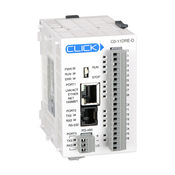 Cookies are not enabled on your browser.
Cookies are not enabled on your browser.Cookies are required for our site. Please enable cookies in your browser preferences to continue.
- Barcode / RFID / Vision
- Bulk Wire & Cable
- Cables (Terminated)
- Circuit Protection / Fuses / Disconnects
- Communications
- Drives & Soft Starters
- Enclosure Thermal Management & Lights
- Enclosures & Racks
- Field I/O
- HMI (Human Machine Interface)
- Hydraulic Components
- Motion Control
- Motor Controls
- Motors
- Pneumatic Components
- Power Products (Electrical)
- Power Transmission (Mechanical)
- Process Control & Measurement
- Programmable Controllers
- Pushbuttons / Switches / Indicators
- Relays / Timers
- Safety
- Sensors / Encoders
- Stacklights
- Structural Frames / Rails
- Tools & Test Equipment
- Valves
- Water (Potable) Components
- Wire & Cable Management
- Wire & Cable Termination
- Retired Products
Configuration Utilities
- PLC Family Selector
- P1000 PLC Systems
- P2000 PLC Systems
- P3000 PLC Systems
- ProductivityCODESYS
- CLICK PLC Systems
- Do-more® BRX PLC Systems
- LS-Electric® XGB PLC Systems
- Productivity®Open Systems
- Datalogic® Safety Light Curtains
- LS-Electric® Servo Systems
- Nitra® Pneumatic Grippers
- Object Detection (Sensors)
- PAL Controller Configurator
- Precision Gearbox Selector
- Protos X® Field I/O
- Pyrometers Selector
- Quadritalia® Modular Enclosures
- Stellar® Soft Starters
- Stepper System Selector
- SureFrame T-slot Extrusion
- SureMotion® XYZ Gantry
- SureServo2® System Selector
- SureStep® Linear Actuators
- Timing Belts & Pulleys
- Werma® Stacklights
- ZIPLinks
Choose from thirty-one CPU modules...
The following CLICK CPU modules are available.. Up to 8 I/O modules can be connected to a CLICK CPU module to expand the system I/O count and meet the needs of a specific application.
- CLICK PLC CPU Modules start at $104.00
- Use a CLICK CPU as a standalone PLC OR add up to 8 I/O Modules for increased capability
- Rackless system saves panel space
- Learn more about How To Choose I/O type.
CLICK CPU Modules

Basic CPU Modules...
...include two RS-232 serial ports, eight discrete input and six discrete output points. Basic CPUs do NOT have a calendar/clock or battery backup (there is a super-capacitor that will save retentive memory values for several days only). The only differences between the CPUs in the Basic family are the I/O type of the inputs and outputs.
Standard CPU Modules...
...include two RS-232 serial ports, plus an RS-485 serial port, eight discrete input and six discrete output points. Standard CPUs have also have battery back-up, & calendar/clock. The only differences between the CPUs in the Standard family are the I/O type of the inputs and outputs.
Analog CPU Modules...
..include two RS-232 serial ports, plus an RS-485 serial port, four discrete input and four discrete output points. Analog CPUs also have two analog input channels and two analog output channels. Analog CPUs DO have the battery back-up, & calendar/clock. The only differences between the CPUs in the Analog family are the I/O type of the inputs and outputs.
Basic Ethernet CPU Modules...
...include one Ethernet port, one RS-232 serial port, eight discrete input and six discrete output points. Basic Ethernet CPUs DO have the battery back-up, & calendar/clock. They also have a faster processor, and support high-speed inputs, PID, and "run time edits". The only differences between the CPUs in the Basic Ethernet family are the I/O type of the inputs and outputs.
Standard Ethernet CPU Modules...
...include one Ethernet port, one RS-232 serial port, and one RS-485 serial port, eight discrete input and six discrete output points. Standard Ethernet CPUs DO have the battery back-up, & calendar/clock. They also have a faster processor, and support high-speed inputs, PID, and "run time edits". The only differences between the CPUs in the Standard Ethernet family are the I/O type of the inputs and outputs.
Ethernet Analog CPU Modules...
...include one Ethernet port, one RS-232 serial port, and one RS-485 serial port, four discrete input and four discrete output points, up to 6 analog I/O channels, a battery back-up, and calendar/clock. They also have a faster processor, and support high-speed inputs, PID, and "run time edits". The only differences between the CPUs in the Ethernet Analog family are the discrete (AC, DC sink, source) and analog (current, voltage, or both) I/O type and the number of analog inputs.
C0-12DD1E-D

4 DC Inputs
4 DC Outputs
(Sinking)
2 Analog Inputs
2 Analog Outputs
(current/voltage)
$278.00
C0-12DD2E-D

4 DC Inputs
4 DC Outputs
(Sourcing)
2 Analog Inputs
2 Analog Outputs
(current/voltage)
$276.00
C0-12DD2E-1-D

4 DC Inputs
4 DC Outputs
(Sourcing)
4 Analog Inputs
2 Analog Outputs
(current)
$277.00
C0-12DD2E-2-D

4 DC Inputs
4 DC Outputs
(Sourcing)
4 Analog Inputs
2 Analog Outputs
(voltage)
$276.00
Check out our job openings
Free Online PLC Training
FREE Video Tutorials
FREE e-Newsletter
Automation Notebook
Product Literature
White Papers
News, Product and Training Bulletins
E-Books
 Safe &
Secure
Safe &
Secure

We accept VISA, MasterCard, Discover, American Express, PayPal or company purchase orders.
Voted #1 mid-sized employer in Atlanta
Check out our
job openings

